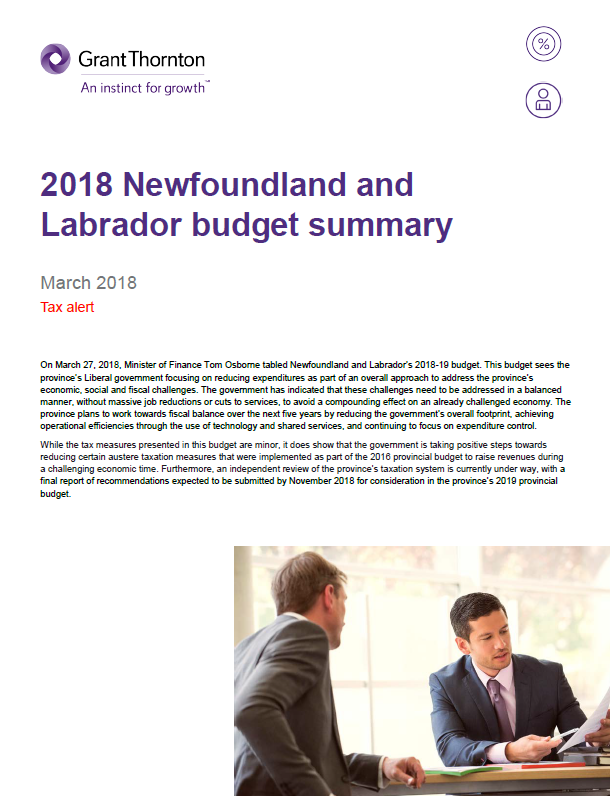-
Financial reporting and accounting advisory services
You trust your external auditor to deliver not only a high-quality, independent audit of your financial statements but to provide a range of support, including assessing material risks, evaluating internal controls and raising awareness around new and amended accounting standards.
-
Accounting Standards for Private Enterprises
Get the clear financial picture you need with the accounting standards team at Doane Grant Thornton LLP. Our experts have extensive experience with private enterprises of all sizes in all industries, an in-depth knowledge of today’s accounting standards, and are directly involved in the standard-setting process.
-
International Financial Reporting Standards
Whether you are already using IFRS or considering a transition to this global framework, Doane Grant Thornton LLP’s accounting standards team is here to help.
-
Accounting Standards for Not-for-Profit Organizations
From small, community organizations to large, national charities, you can count on Doane Grant Thornton LLP’s accounting standards team for in-depth knowledge and trusted advice.
-
Public Sector Accounting Standards
Working for a public-sector organization comes with a unique set of requirements for accounting and financial reporting. Doane Grant Thornton LLP’s accounting standards team has the practical, public-sector experience and in-depth knowledge you need.
-
Tax planning and compliance
Whether you are a private or public organization, your goal is to manage the critical aspects of tax compliance, and achieve the most effective results. At Doane Grant Thornton, we focus on delivering relevant advice, and providing an integrated planning approach to help you fulfill compliance obligations.
-
Research and development and government incentives
Are you developing innovative processes or products, undertaking experimentation or solving technological problems? If so, you may qualify to claim SR&ED tax credits. This Canadian federal government initiative is designed to encourage and support innovation in Canada. Our R&D professionals are a highly-trained, diverse team of practitioners that are engineers, scientists and specialized accountants.
-
Indirect tax
Keeping track of changes and developments in GST/HST, Quebec sales tax and other provincial sales taxes across Canada, can be a full-time job. The consequences for failing to adequately manage your organization’s sales tax obligations can be significant - from assessments, to forgone recoveries and cash flow implications, to customer or reputational risk.
-
US corporate tax
The United States has a very complex and regulated tax environment, that may undergo significant changes. Cross-border tax issues could become even more challenging for Canadian businesses looking for growth and prosperity in the biggest economy in the world.
-
Cross-border personal tax
In an increasingly flexible world, moving across the border may be more viable for Canadians and Americans; however, relocating may also have complex tax implications.
-
International tax
While there is great opportunity for businesses looking to expand globally, organizations are under increasing tax scrutiny. Regardless of your company’s size and level of international involvement—whether you’re working abroad, investing, buying and selling, borrowing or manufacturing—doing business beyond Canada’s borders comes with its fair share of tax risks.
-
Transfer pricing
Transfer pricing is a complex area of corporate taxation that is concerned with the intra-group pricing of goods, services, intangibles, and financial instruments. Transfer pricing has become a critical governance issue for companies, tax authorities and policy makers, and represents a principal risk area for multinationals.
-
Succession & estate planning
Like many private business owners today, you’ve spent your career building and running your business successfully. Now you’re faced with deciding on a successor—a successor who may or may not want your direct involvement and share your vision.
-
Tax Reporting & Advisory
The financial and tax reporting obligations of public markets and global tax authorities take significant resources and investment to manage. This requires calculating global tax provision estimates under US GAAP, IFRS, and other frameworks, and reconciling this reporting with tax compliance obligations.

-
Transactions
Our transactions group takes a client-centric, integrated approach, focused on helping you make and implement the best financial strategies. We offer meaningful, actionable and holistic advice to allow you to create value, manage risks and seize opportunities. It’s what we do best: help great organizations like yours grow and thrive.
-
Restructuring
We bring a wide range of services to both individuals and businesses – including shareholders, executives, directors, lenders, creditors and other advisors who are dealing with a corporation experiencing financial challenges.
-
Forensics
Market-driven expertise in investigation, dispute resolution and digital forensics
-
Cybersecurity
Viruses. Phishing. Malware infections. Malpractice by employees. Espionage. Data ransom and theft. Fraud. Cybercrime is now a leading risk to all businesses.
-
Consulting
Running a business is challenging and you need advice you can rely on at anytime you need it. Our team dives deep into your issues, looking holistically at your organization to understand your people, processes, and systems needs at the root of your pain points. The intersection of these three things is critical to develop the solutions you need today.
-
Creditor updates
Updates for creditors, limited partners, investors and shareholders.

-
Governance, risk and compliance
Effective, risk management—including governance and regulatory compliance—can lead to tangible, long-term business improvements. And be a source of significant competitive advantage.
-
Internal audit
Organizations thrive when they are constantly innovating, improving or creating new services and products and envisioning new markets and growth opportunities.
-
Certification – SOX
The corporate governance landscape is challenging at the best of times for public companies and their subsidiaries in Canada, the United States and around the world.
-
Third party assurance
Naturally, clients and stakeholders want reassurance that there are appropriate controls and safeguards over the data and processes being used to service their business. It’s critical.
-
 Assurance Important changes coming to AgriInvest in 2025AgriInvest is a business risk management program that helps agricultural producers manage small income declines and improve market income.
Assurance Important changes coming to AgriInvest in 2025AgriInvest is a business risk management program that helps agricultural producers manage small income declines and improve market income. -
 ASPE Sec. 3041 Agriculture Understanding and applying the new ASPE Section 3041 AgricultureThe Canadian Accounting Standards Board (AcSB) has released new guidance on recognizing, measuring and disclosing biological assets and the harvested products of bio assets.
ASPE Sec. 3041 Agriculture Understanding and applying the new ASPE Section 3041 AgricultureThe Canadian Accounting Standards Board (AcSB) has released new guidance on recognizing, measuring and disclosing biological assets and the harvested products of bio assets. -
 Tax alert Agricultural Clean Technology ProgramThe Agricultural Clean Technology Program will provide financial assistance to farmers and agri-businesses to help them reduce greenhouse gas (GHG) emissions.
Tax alert Agricultural Clean Technology ProgramThe Agricultural Clean Technology Program will provide financial assistance to farmers and agri-businesses to help them reduce greenhouse gas (GHG) emissions. -
 Tax alert ACT Program – Research and Innovation Stream explainedThe ACT Research and Innovation Stream provides financial support to organizations engaged in pre-market innovation.
Tax alert ACT Program – Research and Innovation Stream explainedThe ACT Research and Innovation Stream provides financial support to organizations engaged in pre-market innovation.
-
Builders And Developers
Every real estate project starts with a vision. We help builders and developers solidify that vision, transform it into reality, and create value.
-
Rental Property Owners And Occupiers
In today’s economic climate, it’s more important than ever to have a strong advisory partner on your side.
-
Real Estate Service Providers
Your company plays a key role in the success of landlords, investors and owners, but who is doing the same for you?

-
Mining
There’s no business quite like mining. It’s volatile, risky and complex – but the potential pay-off is huge. You’re not afraid of a challenge: the key is finding the right balance between risk and reward. Whether you’re a junior prospector, a senior producer, or somewhere in between, we’ll work with you to explore, discover and extract value at every stage of the mining process.
-
Oil & gas
The oil and gas industry is facing many complex challenges, beyond the price of oil. These include environmental issues, access to markets, growing competition from alternative energy sources and international markets, and a rapidly changing regulatory landscape, to name but a few.
On March 27, 2018, Minister of Finance Tom Osborne tabled Newfoundland and Labrador’s 2018-19 budget. This budget sees the province’s Liberal government focusing on reducing expenditures as part of an overall approach to address the province’s economic, social and fiscal challenges. The government has indicated that these challenges need to be addressed in a balanced manner, without massive job reductions or cuts to services, to avoid a compounding effect on an already challenged economy.
The province plans to work towards fiscal balance over the next five years by reducing the government’s overall footprint, achieving operational efficiencies through the use of technology and shared services, and continuing to focus on expenditure control.
While the tax measures presented in this budget are minor, it does show that the government is taking positive steps towards reducing certain austere taxation measures that were implemented as part of the 2016 provincial budget to raise revenues during a challenging economic time. Furthermore, an independent review of the province’s taxation system is currently underway, with a final report of recommendations expected to be submitted by November 2018 for consideration in the province’s 2019 provincial
budget.
Through its efforts to reduce expenditures, the government of Newfoundland and Labrador is projecting a surplus by the 2022-23 fiscal year.
Fiscal results for the next five years are projected as follows:
| Year | Projected surplus/(deficit) |
| 2017-18 | ($812 million) |
| 2018-19 | ($683 million) |
| 2019-20 | ($507 million) |
| 2020-21 | ($654 million) |
| 2021-22 | ($243 million) |
| 2022-23 | $56 million |
These fiscal projections are based on key estimates that the price of oil will approximate $63 per barrel and the US to Canada exchange rate will approximate US $0.79 in both 2018-19 and 2019-20. Additionally, the projected deficits in 2017-18 and 2018-19 are impacted by the payment of severance expenses greed to under recent collective agreements with public sector employees.
Net debt as a percentage of the province’s GDP is expected to increase until 2020-21 and then begin to decrease. Furthermore, net borrowing for the duration of the government’s 2022-23 fiscal plan is now projected to increase by $1.4 billion, with $1.1 billion of this resulting from changes in cash flows relating to Nalcor Energy.
Health and Post-Secondary Education Tax
The province currently imposes a 2% payroll tax on employers whose annual remuneration exceeds a threshold of $1.2 million. The 2018 provincial budget increases this exemption threshold to $1.3 million effective January 1, 2019. Employers that have been subject to this tax will pay up to $2,000 less in tax starting in 2019.
Search and Rescue Volunteer Tax Credit
Effective January 1, 2019, a $3,000 non-refundable Search and Rescue Volunteer Tax Credit has been introduced to provide personal tax relief to eligible search and rescue volunteers.
Home Purchase Program
A new Home Purchase Program has been introduced as part of the 2018 provincial budget that will provide taxpayers with $3,000 in grants to put towards the purchase of a newly constructed or never before purchased home costing under $400,000.
Carbon tax
It has also been announced that the province is currently in the process of finalizing its approach to carbon pricing, making it among the last of the provinces to announce its carbon pricing plan. It is expected that once this plan becomes effective, the temporary gas tax that was introduced in 2016 will be phased out.
Further details surrounding the carbon pricing plan are expected to be released later in the spring of this year.
Read the full 2018-19 Newfoundland and Labrador budget [ 101 kb ]

